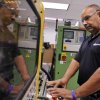In an industrial park in the quiet town of Putnam, Conn., Foster Corp. is mixing up plastics destined for catheters and other medical devices.
Later this month, the privately held company will make a significant financial and logistical leap by ceremonially breaking ground on a new 32,000-square-foot plant nearby, where Foster will be able to blend drug-infused plastics destined for bone screws, skin patches, artificial joints or other medical products.
"This is a very big deal for us," said Brittany L. Palmer, Foster marketing and distribution manager. The company is financing $6.45 million, "but it doesn't include any capital equipment we'll need to put into the facility. We're estimating $8 million overall."
The project is one of at least two medical device business expansions launching in the Worcester area, as the region and nation seek ways to improve medical care and boost economic development while also reining in medical spending.
It's a tricky mix of objectives, as medical device makers continue to rail against an excise tax instituted under the Affordable Care Act to fund health care reform initiatives.
"The last few years have been difficult ones for the medical technology industry," said Thomas J. Sommer, president of MassMEDIC, the Massachusetts Medical Device Industry Council. "We're operating in a new health care environment."
The medical device industry is a mix of research, engineering and manufacturing businesses that churns out products used in diagnosing disease, electromedical equipment, surgical and medical instruments, appliances, products that get implanted in the body and other goods. Analysts also consider it critical to the Massachusetts economy.
Depending on how the industry is defined, Massachusetts medical device businesses employed about 21,000 to 24,000 workers in about 2011 to 2012.
Only two other states boast heftier medical device industries: California, with nearly 70,000 workers in 2010; and Minnesota, with nearly 22,000 workers, according to federal labor statistics.
The industry is also made up largely of small enterprises. Big companies such as Boston Scientific Corp. in Natick lead the medical device industry in revenue and employment, but about half of all U.S. medical device firms employed fewer than 100 people each as of 2007. Many of those smaller firms employed four people or less, according to government statistics.
Workers generally earned good wages, too. The average medical device worker salary in Massachusetts during 2010 was $68,332.
Good-paying jobs
The biotechnology industry gets a good deal of attention in Massachusetts, and sometimes the contributions of the medical device makers get overlooked, said Kevin O'Sullivan, president of the Worcester economic development agency, Massachusetts Biomedical Initiatives.
"There are just as many jobs, if not more, in the medical device industry, and they're good-paying jobs on all fronts, not just Ph.D.s," Mr. O'Sullivan said.
In the Worcester area, some medical device makers are growing. Jabil Circuit Inc. of St. Petersburg, Fla., is expanding its Nypro Inc. plastics molding business in Clinton to an additional manufacturing facility in Devens.
Foster Corp. in Putnam is constructing a new building to blend plastics with pharmaceuticals under stringently sterile conditions for a market that is expanding.
"The new facility will allow us to support the increased demand for next-generation medical devices, requiring extremely precise polymer technologies processed in a cGMP (current good manufacturing practice) clean room environment," Foster founder and Chief Executive Officer Lawrence Acquarulo said in a written statement.
Yet even as some companies expand, medical device makers remain unhappy about a 2.3 percent federal excise tax they must pay on the domestic sale of products to fund provisions of the Affordable Care Act, also known as national health care reform.
The tax aims to raise money from a sector likely to benefit from increased sales as more Americans gained insurance and sought medical treatment. Medical device makers contend the tax would force cuts in jobs and research spending and a shift in manufacturing to overseas locations. Other analyses from organizations such as the think tank Center on Budget and Policy Priorities suggest the fears are overblown.
Massachusetts legislators recently agreed to form a panel to study the impact of the tax and whether a state tax credit should be created to offset the federal excise tax. Mr. Sommer of MassMEDIC is now concerned that appointments to the panel and its work will get delayed by fall elections.
"We're hoping there's at least an initial meeting in the next month, and that work and analysis and a proposal is prepared for the new governor and the new Legislature in the coming year," he said.
By at least one indicator, the medical device industry still retains the confidence of investors. Venture capital investments in U.S. medical device companies hit $649 million during the second quarter this year, up 23 percent over the same period last year, according to a study by PricewaterhouseCoopers LLP and the National Venture Capital Association.
Medical device design and production remains in the sweet spot of Massachusetts capabilities, including engineering, life science knowledge and hospital care, according to Michael D. Goodman, director of the Center for Policy Analysis at the University of Massachusetts at Dartmouth.
"As the population ages both here and around the world, I think, big picture, the outlook for these medical technology intensive firms is positive," he said.
source:Times Of India

